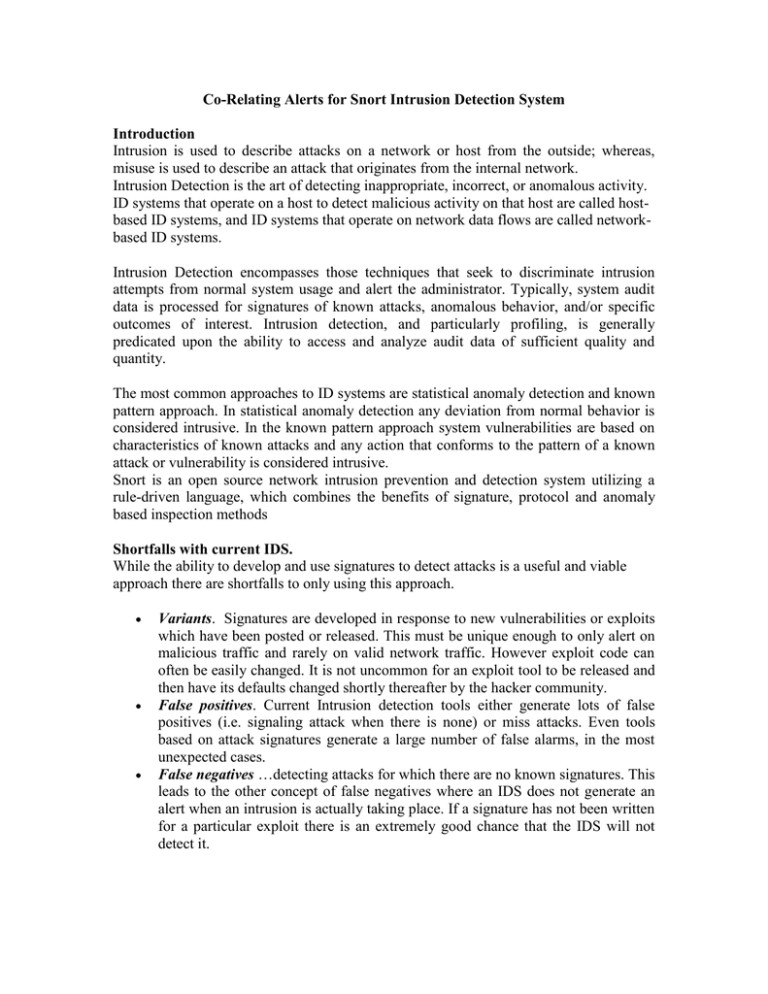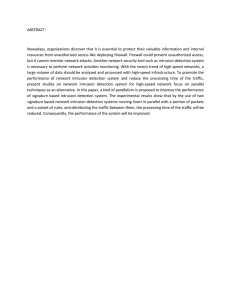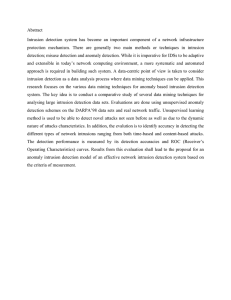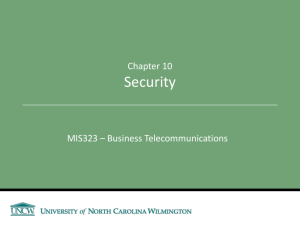Co-Relating Alerts for Snort Intrusion Detection System Introduction
advertisement

Co-Relating Alerts for Snort Intrusion Detection System Introduction Intrusion is used to describe attacks on a network or host from the outside; whereas, misuse is used to describe an attack that originates from the internal network. Intrusion Detection is the art of detecting inappropriate, incorrect, or anomalous activity. ID systems that operate on a host to detect malicious activity on that host are called hostbased ID systems, and ID systems that operate on network data flows are called networkbased ID systems. Intrusion Detection encompasses those techniques that seek to discriminate intrusion attempts from normal system usage and alert the administrator. Typically, system audit data is processed for signatures of known attacks, anomalous behavior, and/or specific outcomes of interest. Intrusion detection, and particularly profiling, is generally predicated upon the ability to access and analyze audit data of sufficient quality and quantity. The most common approaches to ID systems are statistical anomaly detection and known pattern approach. In statistical anomaly detection any deviation from normal behavior is considered intrusive. In the known pattern approach system vulnerabilities are based on characteristics of known attacks and any action that conforms to the pattern of a known attack or vulnerability is considered intrusive. Snort is an open source network intrusion prevention and detection system utilizing a rule-driven language, which combines the benefits of signature, protocol and anomaly based inspection methods Shortfalls with current IDS. While the ability to develop and use signatures to detect attacks is a useful and viable approach there are shortfalls to only using this approach. Variants. Signatures are developed in response to new vulnerabilities or exploits which have been posted or released. This must be unique enough to only alert on malicious traffic and rarely on valid network traffic. However exploit code can often be easily changed. It is not uncommon for an exploit tool to be released and then have its defaults changed shortly thereafter by the hacker community. False positives. Current Intrusion detection tools either generate lots of false positives (i.e. signaling attack when there is none) or miss attacks. Even tools based on attack signatures generate a large number of false alarms, in the most unexpected cases. False negatives …detecting attacks for which there are no known signatures. This leads to the other concept of false negatives where an IDS does not generate an alert when an intrusion is actually taking place. If a signature has not been written for a particular exploit there is an extremely good chance that the IDS will not detect it. Data overload. Depending on the intrusion detection tools employed by a company and its size there is the possibility for logs to reach millions of records per day. Need for co-relation: One of the most obvious reasons why false alarms occur is because tools are stateless. To detect an intrusion, simple pattern matching of signatures is often insufficient. There are many events happening in the course of the normal life of any system or network that can be mistaken for attacks. A lot of sysadmin activity can be catalogued as anomalous. Therefore, a clear correlation between attack data and administrative data should be established to cross-check that everything happening on a system is actually desired. Traditional intrusion detection systems (IDSs) focus on low-level attacks or anomalies, and raise alerts independently, though there may be logical connections between them. In situations where there are intensive attacks, not only will actual alerts be mixed with false alerts, but the amount of alerts will also become unmanageable. As a result, it is difficult for human users or intrusion response systems to understand the alerts and take appropriate actions. Consider the network intrusion caused due to a Distributed Denial of Service (DDoS) attack. During a DDoS, the adversary usually launches attacks against the chosen victims indirectly. Specifically, the adversary first probes a network to locate the “up” hosts(phase 1). After determining which hosts are alive, the adversary breaks into some of them, installs relevant tools (phase 2) and launches DDoS via these victims (phase 3), which serve as the springboard of the attack. In such a case tracing the true source through the alerts is infeasible and a large volume of false alerts tend to be raised by an IDS. Hence, it is necessary to reduce the irrelevant alerts and fuse related ones before they are presented to the administrators, which will facilitate alert processing and ultimately improve the detection performance. Various Approaches to Alert Co-relation Our Approach In the approach taken in our project, we decided to do Rule Classification in order to do Alert Correlation. The rationale behind this approach is that all alerts are due to some rule match in a packet. For an attack to be successful there have to be different stages, which means multiple packets will be sent. Rules could be classified depending on the different stages of the attack. For instance all alerts generated due to an ICMP echo request, or a ping which leads to network discovery could be classified under one class. We decided on the following Rule Classes: Network Discovery 2 Scan for entry points 3 Information Gathering 4 Exploit Snort Rules Snort has some 3000 odd rules in its rules database. The information available with a rule is typically as follows: Message DOS Land attack Summary A DoS attack known as Land has been launched. Some TCP/IP stacks crash or hang when sent a spoofed TCP SYN packet with the same source and destination host and the same source and destination port. Attack Scenarios Ease of Attack False Positives False Negatives Corrective Action nmap –sS –O 172.26.1.0/29 There are three distinct phases with the above nmap command. They are: 1) Host discovery 2) Port scanning 3) OS fingerprinting


